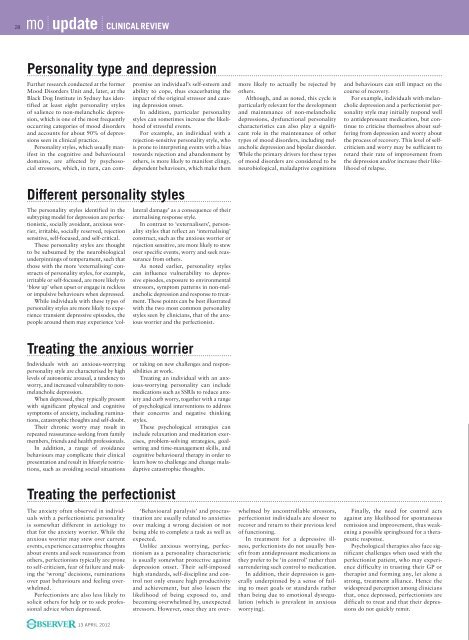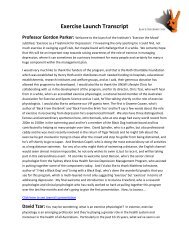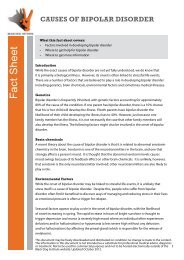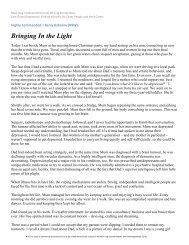Personality type and depression - Black Dog Institute
Personality type and depression - Black Dog Institute
Personality type and depression - Black Dog Institute
Create successful ePaper yourself
Turn your PDF publications into a flip-book with our unique Google optimized e-Paper software.
28 mo update clinical review<strong>Personality</strong> <strong>type</strong> <strong>and</strong> <strong>depression</strong>Further research conducted at the formerMood Disorders Unit <strong>and</strong>, later, at the<strong>Black</strong> <strong>Dog</strong> <strong>Institute</strong> in Sydney has identifiedat least eight personality stylesof salience to non-melancholic <strong>depression</strong>,which is one of the most frequentlyoccurring categories of mood disorders<strong>and</strong> accounts for about 90% of <strong>depression</strong>sseen in clinical practice.<strong>Personality</strong> styles, which usually manifestin the cognitive <strong>and</strong> behaviouraldomains, are affected by psychosocialstressors, which, in turn, can compromisean individual’s self-esteem <strong>and</strong>ability to cope, thus exacerbating theimpact of the original stressor <strong>and</strong> causing<strong>depression</strong> onset.In addition, particular personalitystyles can sometimes increase the likelihoodof stressful events.For example, an individual with arejection-sensitive personality style, whois prone to interpreting events with a biastowards rejection <strong>and</strong> ab<strong>and</strong>onment byothers, is more likely to manifest clingy,dependent behaviours, which make themmore likely to actually be rejected byothers.Although, <strong>and</strong> as noted, this cycle isparticularly relevant for the development<strong>and</strong> maintenance of non-melancholic<strong>depression</strong>s, dysfunctional personalitycharacteristics can also play a significantrole in the maintenance of other<strong>type</strong>s of mood disorders, including melancholic<strong>depression</strong> <strong>and</strong> bipolar disorder.While the primary drivers for these <strong>type</strong>sof mood disorders are considered to beneurobiological, maladaptive cognitions<strong>and</strong> behaviours can still impact on thecourse of recovery.For example, individuals with melancholic<strong>depression</strong> <strong>and</strong> a perfectionist personalitystyle may initially respond wellto antidepressant medication, but continueto criticise themselves about sufferingfrom <strong>depression</strong> <strong>and</strong> worry aboutthe process of recovery. This level of selfcriticism<strong>and</strong> worry may be sufficient toretard their rate of improvement fromthe <strong>depression</strong> <strong>and</strong>/or increase their likelihoodof relapse.Different personality stylesThe personality styles identified in thesubtyping model for <strong>depression</strong> are perfectionistic,socially avoidant, anxious worrier,irritable, socially reserved, rejectionsensitive, self-focused, <strong>and</strong> self-critical.These personality styles are thoughtto be subsumed by the neurobiologicalunderpinnings of temperament, such thatthose with the more ‘externalising’ constructsof personality styles, for example,irritable or self-focused, are more likely to‘blow up’ when upset or engage in recklessor impulsive behaviours when depressed.While individuals with these <strong>type</strong>s ofpersonality styles are more likely to experiencetransient depressive episodes, thepeople around them may experience ‘collateraldamage’ as a consequence of theireternalising response style.In contrast to ‘externalisers’, personalitystyles that reflect an ‘internalising’construct, such as the anxious worrier orrejection sensitive, are more likely to stewover specific events, worry <strong>and</strong> seek reassurancefrom others.As noted earlier, personality stylescan influence vulnerability to depressiveepisodes, exposure to environmentalstressors, symptom patterns in non-melancholic<strong>depression</strong> <strong>and</strong> response to treatment.These points can be best illustratedwith the two most common personalitystyles seen by clinicians, that of the anxiousworrier <strong>and</strong> the perfectionist.Treating the anxious worrierIndividuals with an anxious-worryingpersonality style are characterised by highlevels of autonomic arousal, a tendency toworry, <strong>and</strong> increased vulnerability to nonmelancholic<strong>depression</strong>.When depressed, they typically presentwith significant physical <strong>and</strong> cognitivesymptoms of anxiety, including ruminations,catastrophic thoughts <strong>and</strong> self-doubt.Their chronic worry may result inrepeated reassurance-seeking from familymembers, friends <strong>and</strong> health professionals.In addition, a range of avoidancebehaviours may complicate their clinicalpresentation <strong>and</strong> result in lifestyle restrictions,such as avoiding social situationsor taking on new challenges <strong>and</strong> responsibilitiesat work.Treating an individual with an anxious-worryingpersonality can includemedications such as SSRIs to reduce anxiety<strong>and</strong> curb worry, together with a rangeof psychological interventions to addresstheir concerns <strong>and</strong> negative thinkingstyles.These psychological strategies caninclude relaxation <strong>and</strong> meditation exercises,problem-solving strategies, goalsetting<strong>and</strong> time-management skills, <strong>and</strong>cognitive behavioural therapy in order tolearn how to challenge <strong>and</strong> change maladaptivecatastrophic thoughts.Perfectionists donot usually benefitfrom antidepressantmedication.iStockphoto.comTreating the perfectionistThe anxiety often observed in individualswith a perfectionistic personalityis somewhat different in aetiology tothat for the anxiety worrier. While theanxious worrier may stew over currentevents, experience catastrophic thoughtsabout events <strong>and</strong> seek reassurance fromothers, perfectionists typically are proneto self-criticism, fear of failure <strong>and</strong> makingthe ‘wrong’ decisions, ruminationsover past behaviours <strong>and</strong> feeling overwhelmed.Perfectionists are also less likely tosolicit others for help or to seek professionaladvice when depressed.‘Behavioural paralysis’ <strong>and</strong> procrastinationare usually related to anxietiesover making a wrong decision or notbeing able to complete a task as well asexpected.Unlike anxious worrying, perfectionismas a personality characteristicis usually somewhat protective against<strong>depression</strong> onset. Their self-imposedhigh st<strong>and</strong>ards, self-discipline <strong>and</strong> controlnot only ensure high productivity<strong>and</strong> achievement, but also lessen thelikelihood of being exposed to, <strong>and</strong>becoming overwhelmed by, unexpectedstressors. However, once they are overwhelmedby uncontrollable stressors,perfectionist individuals are slower torecover <strong>and</strong> return to their previous levelof functioning.In treatment for a depressive illness,perfectionists do not usually benefitfrom antidepressant medications asthey prefer to be ‘in control’ rather thansurrendering such control to medication.In addition, their <strong>depression</strong> is generallyunderpinned by a sense of failingto meet goals or st<strong>and</strong>ards ratherthan being due to emotional dysregulation(which is prevalent in anxiousworrying).Finally, the need for control actsagainst any likelihood for spontaneousremission <strong>and</strong> improvement, thus weakeninga possible springboard for a therapeuticresponse.Psychological therapies also face significantchallenges when used with theperfectionist patient, who may experiencedifficulty in trusting their GP ortherapist <strong>and</strong> forming any, let alone astrong, treatment alliance. Hence thewidespread perception among cliniciansthat, once depressed, perfectionists aredifficult to treat <strong>and</strong> that their <strong>depression</strong>sdo not quickly remit.13 APRil 2012
















